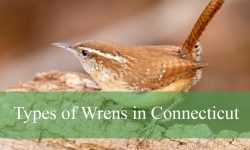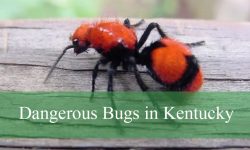Wrens are small but full of character, and Wisconsin is lucky to host several fascinating species each year. From the cheerful House Wren singing in backyards to the secretive Marsh Wren hiding among cattails, these tiny birds bring energy and personality to every corner of the state. Spending time outdoors, I often catch their quick movements and lively songs, reminding me how much beauty is tucked away in the smallest of creatures.
Exploring Wisconsin’s fields, forests, and wetlands, I’ve learned that each wren has its own story. Some, like the Winter Wren, prefer the cool shade of northern woodlands, while others, such as the Carolina Wren, thrive in backyards even through the cold months. With a little patience and curiosity, birdwatchers can discover all seven types of wrens that call Wisconsin home.
Different Types of Wrens Found in Wisconsin
House Wren
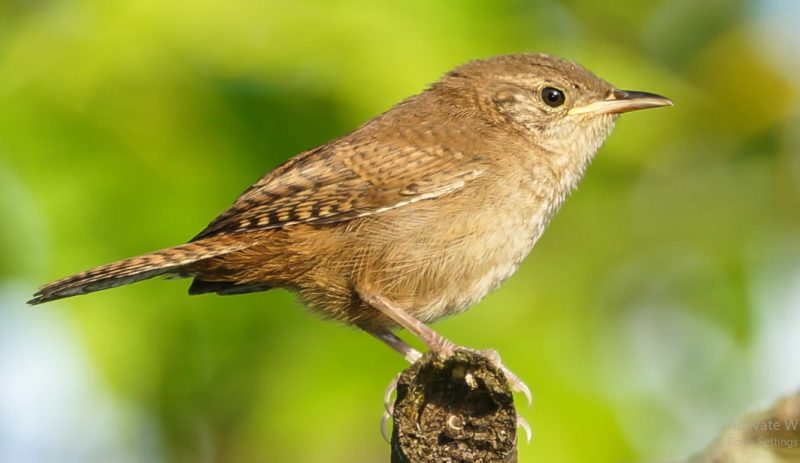
The House Wren is one of the most familiar wrens found in Wisconsin, known for its lively nature and constant singing during the warmer months. This small bird measures around 4.3 to 5.1 inches in length with a wingspan of 5.9 to 6.7 inches. Its plumage is mostly brown with fine barring on the wings and tail, giving it a somewhat plain appearance, yet its energetic movements make it easy to notice in gardens and woodlots.
In terms of identification, the House Wren has a short tail often held upright, a slightly curved bill, and no distinctive markings compared to some other wrens. Its song is a bubbly, rattling series of notes that is delivered persistently, especially during the breeding season. Males are known to build multiple nests from twigs and other materials, allowing females to choose one for raising their young.
Behaviorally, House Wrens are highly territorial and will aggressively defend their nesting sites, sometimes even removing the eggs of other cavity-nesting birds. They forage actively in shrubs, tree branches, and on the ground, searching for insects, spiders, and other small invertebrates. Their restless nature and frequent flicking of wings and tail make them easy to spot when active.
A fun fact about House Wrens in Wisconsin is their adaptability to human presence. They readily nest in birdhouses, mailboxes, or any available cavity, making them common visitors to backyards. During the summer, they are found across much of the state in open woodlands, parks, and suburban areas, before migrating south to Central America and the southern United States for winter.
Marsh Wren
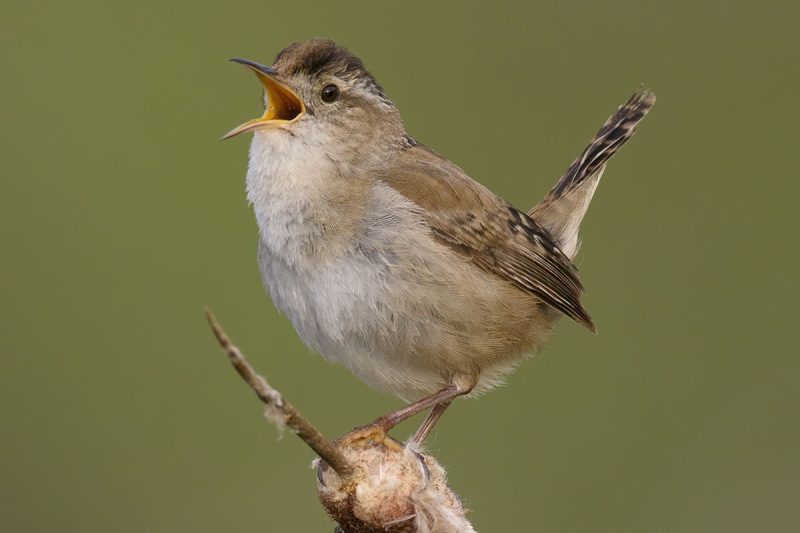
The Marsh Wren is a small, secretive bird that thrives in Wisconsin’s wetlands and cattail marshes. Measuring about 3.9 to 5.5 inches long with a wingspan of 5.9 inches, this species is slightly smaller and slimmer than the House Wren. Its plumage is dark brown above with bold white stripes running down its back, while the underparts are pale buff to whitish. Its short tail is usually cocked upward, a typical wren trait.
Identification is easiest by listening to its distinctive song, which is a rapid series of gurgling, buzzing, and chattering notes that echo across marshes in spring and summer. Unlike other wrens, the Marsh Wren often sings even at night, especially during peak breeding season. Its call is harsh and mechanical, contrasting with the melodious notes of the House Wren.
Marsh Wrens are highly active and spend most of their time clinging to cattail stems or darting between reeds in search of food. Their diet mainly consists of insects, spiders, and aquatic invertebrates. They often glean prey from vegetation, sometimes hanging upside down to reach hidden insects. Males build several dummy nests from grasses and cattails, but only one is used for raising the brood.
A fun fact is that Marsh Wrens are sometimes called “reed wrens” because of their close association with cattails and bulrushes. In Wisconsin, they are found mostly in southern and central parts of the state where wetlands are more common. They migrate southward in fall, wintering in the southern U.S. and Mexico before returning in late April or May.
Sedge Wren
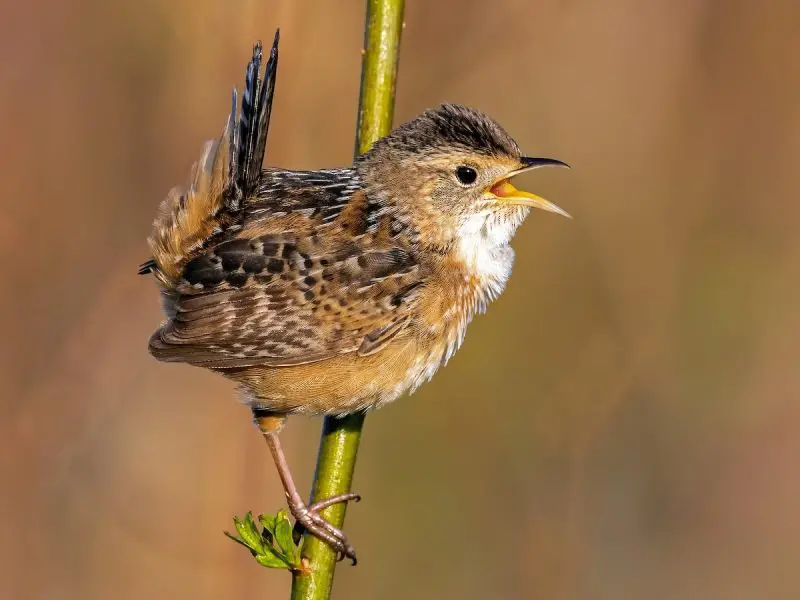
The Sedge Wren is a smaller, more elusive cousin of the Marsh Wren, often found in Wisconsin’s grassy meadows and sedge fields rather than cattail marshes. This bird is about 3.9 to 4.7 inches long with a wingspan of around 5.7 inches. Its plumage is mottled brown and buff with a streaked crown and finely barred wings and tail, giving it excellent camouflage in grassy habitats.
Unlike the Marsh Wren, the Sedge Wren’s song is a dry, insect-like chatter that repeats in bursts, sounding much like a sewing machine. They sing most actively at dawn and dusk, which helps birders locate them in the tall grasses. Their secretive habits and tendency to crouch low in vegetation make them challenging to observe closely.
These wrens are opportunistic breeders, often nesting later in the summer when conditions are right. Their diet is composed of insects, spiders, and small invertebrates, which they pick from grasses and sedges. Males build multiple domed nests woven from grasses, but only one is chosen for actual nesting.
A fun fact about the Sedge Wren in Wisconsin is that they are sometimes unpredictable in their distribution, appearing in certain grasslands one year and absent the next. This nomadic pattern is linked to water levels and habitat availability. They are summer residents in Wisconsin, particularly in southern and western areas, before migrating to the southeastern United States and Central America for the winter.
Winter Wren

The Winter Wren is one of the smallest wrens in Wisconsin, measuring only 3.1 to 4.7 inches long with a wingspan of about 6 inches. Despite its tiny size, it has a rich, cascading song that is considered one of the most beautiful among North American birds. Its plumage is dark brown with fine barring all over, and it has a very short tail that is often held upright.
This species is distinctive because of its compact, round body and tiny bill. When observed in Wisconsin’s forests, it often appears to be a small, dark shadow flitting among roots, logs, and underbrush. Its song is a long, complex series of trills and notes that carries surprisingly far, even though the bird itself is barely larger than a mouse.
Winter Wrens forage low to the ground, probing moss, bark, and leaf litter for insects, spiders, and beetles. They are active, constantly hopping and flicking their wings as they search for food. During the breeding season, males build multiple small dome-shaped nests, usually hidden among tree roots or fallen logs, which helps protect them from predators.
A fun fact about the Winter Wren is that despite its name, it is mostly a summer breeder in Wisconsin’s northern forests. It prefers cool, moist coniferous habitats, especially spruce and fir forests. In winter, most migrate southward to the eastern United States, though a few may linger in sheltered areas of Wisconsin during milder seasons.
Carolina Wren

The Carolina Wren is a year-round resident in southern Wisconsin, known for its bold personality and loud, ringing song. It is larger than many other wrens, measuring about 4.7 to 5.5 inches long with a wingspan of 11 inches. Its plumage is warm reddish-brown above and buff-colored below, with a distinctive white eyebrow stripe that makes it easy to identify. The long, slightly curved bill and rounded body give it a characteristic wren look.
Unlike some of the more secretive wrens, Carolina Wrens are not shy about being near people. They frequent backyards, brush piles, and wooded edges, often singing from exposed perches. Their song is a series of repeated, whistled notes that sound like “teakettle-teakettle-teakettle,” and both males and females produce a wide variety of calls.
In terms of diet, Carolina Wrens feed primarily on insects and spiders, but they will also eat fruit, berries, and even suet from feeders in colder months. They forage actively on the ground and in shrubs, probing crevices and bark for prey. Their adaptability allows them to survive harsh winters as long as they find adequate shelter and food sources.
A fun fact is that Carolina Wrens often roost in unusual places, including hanging flowerpots, garages, and mailboxes. In Wisconsin, their northern range is limited by cold winters, but they are slowly expanding northward thanks to slightly milder conditions and the availability of bird feeders.
Rock Wren
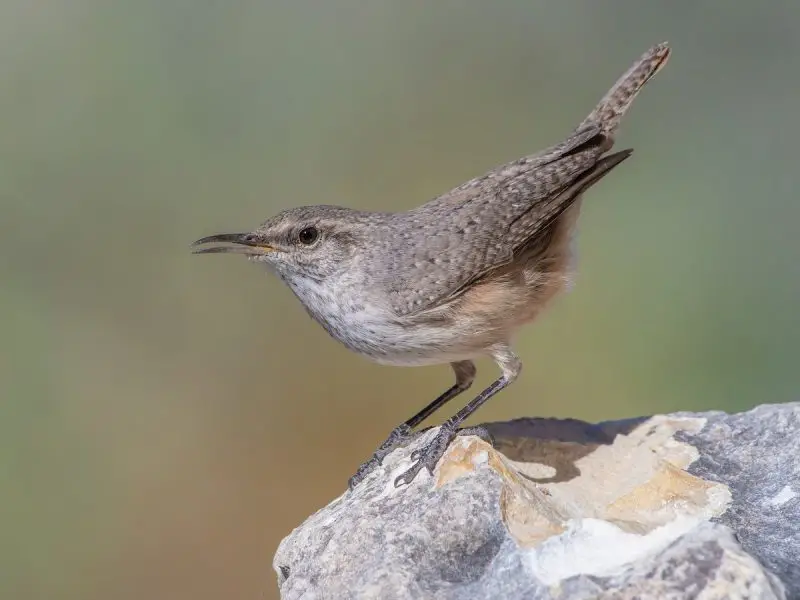
The Rock Wren is an uncommon visitor in Wisconsin, usually seen only during migration or as a rare wanderer in rocky areas. This bird measures 5.9 to 6.7 inches long with a wingspan of 9 to 10 inches, making it one of the larger wrens. Its plumage is grayish-brown above with fine streaking and a paler belly, giving it excellent camouflage against rocks and gravel. A faint white eyebrow line helps distinguish it from other wrens.
This species is adapted to dry, rocky environments and is more typical of the western United States. In Wisconsin, they may be spotted near quarries, rocky bluffs, or open gravelly areas, though such sightings are unusual. Their song is a sweet series of warbling and trilling notes, which they often sing while perched on a rock or elevated surface.
Rock Wrens feed mostly on insects, including beetles, grasshoppers, and ants, which they pick from rocky crevices or bare ground. They are known for their unique behavior of hopping along rocks in search of food and occasionally flicking their tails and wings. Unlike many wrens that favor dense vegetation, Rock Wrens are comfortable in open spaces with sparse cover.
A fun fact is that Rock Wrens often place small pebbles around the entrance of their nests, which are built in crevices or under rocks. This unusual nesting habit has fascinated birders and scientists alike. In Wisconsin, their presence is sporadic, but dedicated birdwatchers may encounter them during rare occurrences.
Bewick’s Wren
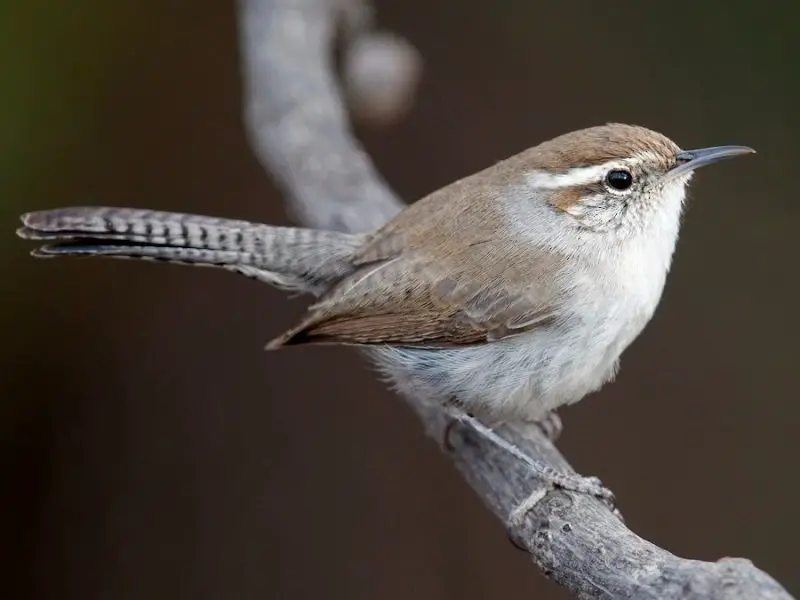
The Bewick’s Wren is a rare and local species in Wisconsin, more commonly found in the southern and western United States. It measures about 5.1 inches long with a wingspan of 7 inches. Its appearance is slender with a long tail that is frequently flicked sideways and upward. The plumage is grayish-brown above and whitish below, with a very prominent white eyebrow stripe that makes it easy to distinguish from other wrens.
This species is more often associated with shrubby thickets, brushy fields, and woodland edges. In Wisconsin, sightings are uncommon, but they occasionally appear in southern parts of the state. Their song is a loud, musical series of notes and trills, often varying in rhythm and tone depending on the individual bird.
Bewick’s Wrens feed mainly on insects, spiders, and larvae, which they glean from foliage, bark, and low shrubs. They are agile foragers, moving quickly through tangled vegetation and using their slender bill to probe into crevices. They may also visit feeders for suet or mealworms if available.
A fun fact is that the Bewick’s Wren was once much more widespread in the eastern United States, but its population has declined significantly in those areas due to habitat loss and competition with House Wrens. Today, they are considered uncommon in Wisconsin, but birdwatchers keep an eye out for these charming, long-tailed wrens during migration.
FAQs About Wrens in Wisconsin
What types of wrens can be found in Wisconsin?
Wisconsin is home to seven species of wrens: House Wren, Marsh Wren, Sedge Wren, Winter Wren, Carolina Wren, Rock Wren, and Bewick’s Wren. Some, like the House Wren and Marsh Wren, are common summer residents, while others such as the Rock Wren and Bewick’s Wren are considered rare visitors.
Which wren is the most common in Wisconsin?
The House Wren is the most widespread and familiar species across the state. They are frequently seen in backyards, gardens, and woodlands during the summer months. Their adaptability and willingness to nest near people make them the easiest wren to spot in Wisconsin.
Where is the best place to see Marsh Wrens in Wisconsin?
Marsh Wrens are best observed in cattail wetlands and reed beds, particularly in southern and central parts of the state. Birdwatchers often locate them by their loud, chattering songs echoing through marshes from late spring through summer.
Do wrens stay in Wisconsin year-round?
Most wrens migrate south for the winter. The House, Marsh, Sedge, and Winter Wrens are mainly summer residents. The Carolina Wren, however, can survive year-round in southern Wisconsin, especially if food sources like suet feeders are available. Rarely, some Winter Wrens may linger in sheltered forests during milder winters.
What do wrens eat in Wisconsin?
Wrens feed primarily on insects, spiders, and other small invertebrates. They forage actively in shrubs, grasses, and forest understories, often probing into crevices and leaf litter. Some species, like the Carolina Wren, will also eat berries and suet, especially in colder months.
How can I attract wrens to my backyard in Wisconsin?
To attract wrens, provide birdhouses, brush piles, and dense shrubs for shelter. House Wrens readily use nest boxes, while Carolina Wrens may take advantage of sheltered corners or hanging flowerpots. Offering suet or mealworms can also encourage them to visit.
Why are Bewick’s Wrens so rare in Wisconsin?
Bewick’s Wrens were once common across the eastern United States, but their numbers declined due to habitat loss and competition with House Wrens. Today, they are more frequently found in the southern and western U.S., with only occasional appearances in Wisconsin.
What is a fun fact about Wisconsin wrens?
A fascinating behavior is seen in Rock Wrens, which sometimes line their nests with tiny pebbles around the entrance. Another fun fact is that House Wrens in Wisconsin may nest in unusual places such as mailboxes, boots, and even old cans, showing their remarkable adaptability.




